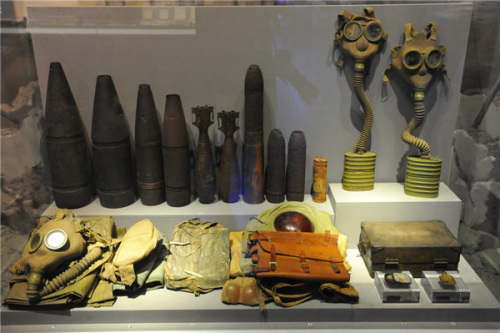
Some equipment of chemical warfare the Japanese army used in China during World War II.
Li says the details of many touching individual stories in the displays resonate among visitors. For example, farewell letters left by Chinese soldiers to their families before setting off for battlefields are shown to the public.
Also highlighted: the international cooperation to fight against the Axis during WWII. For example, the Kuomintang-led Chinese Expeditionary Forces to Burma (today's Myanmar) and the efforts of a Chinese diplomat, He Fengshan, in Vienna, to save Jewish people from Hitler's gas chambers.
Tools used by people in Sichuan province to construct an airport were also collected by the museum to put on show. Stone rollers, for example, were used to pave the runaways.
During the war, the Allies' air forces once launched most of their raids on Japanese targets from Chinese bases. Some US bombers that ran out of oil also landed on China, like those in James Doolittle's famous raid on Tokyo in 1942. Bulletins guiding Chinese people to save US pilots are also among the exhibits.
Some previously lesser-known perspectives of the war for the Chinese public are also revealed, like a Chinese journalist's reports from the Eastern Front, and Chinese engineers' contribution to the success of the Normandy landings.
"When we put Chinese people's resistance in the backdrop of the world's fights against fascism, it shows how many contributions we made to the final result."
According to official Chinese statistics, the Japanese side had 1.5 million casualties. Before the Pacific War broke out, about 70 percent of Japan's troops were stuck in Chinese battlefields. However, the Japanese invasion also led China to lose about 35 million soldiers and civilians.
An online platform memorializing that war was also launched on the museum's official website. Web users are also able to provide their old pictures and file records of the war at this virtual memorial hall.
"We stick to the facts and history talk," Li says. "Only the abundant files can vividly show Chinese people's persistent struggle and glorious victory."
Contact the writer at wangkaihao@chinadaily.com.cn
If you go
9 am-4:30 pm (closed on Mondays). 1 Inner Street of Wanping Fortress, Lugouqiao, Fengtai district, Beijing. 010-8389-6220. www.1937china.com.


















































